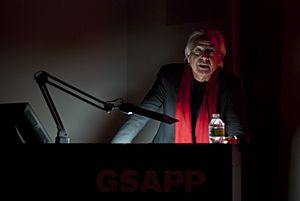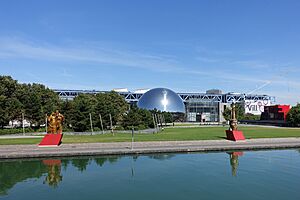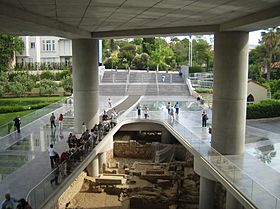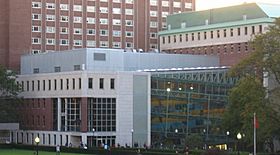Bernard Tschumi facts for kids
Bernard Tschumi was born on January 25, 1944, in Lausanne, Switzerland. He is a famous architect, writer, and teacher. He is known for his unique ideas about how buildings should be designed.
Bernard Tschumi has both French and Swiss citizenship. He lives and works in New York City and Paris. He studied architecture in Paris and at ETH in Zurich, Switzerland. He earned his architecture degree in 1969.
Contents
Bernard Tschumi's Career in Architecture
Bernard Tschumi has taught architecture in many places. He taught in the UK and the USA. Some of these places include Portsmouth University and the Architectural Association in London. He also taught at Princeton University and Columbia University.
From 1988 to 2003, he was the Dean of Columbia University's Graduate School of Architecture, Planning and Preservation. This means he was in charge of the architecture school there.
Important Projects and Buildings
Tschumi's first big project was the Parc de la Villette in Paris. He won a competition to design this park in 1983. It became a very famous project.
Other important buildings he designed include the Acropolis Museum in Athens, Greece. He also designed the Rouen Concert Hall in France. Over his long career, he has completed more than sixty building projects.
In 1996, he received the French Grand Prix National d'Architecture. This is a major award for architects in France. He started his own architecture firm in Paris in 1983. Later, he opened Bernard Tschumi Architects (BTA) in New York City in 1988.
Bernard Tschumi's Ideas About Design
Bernard Tschumi believes that architecture is more than just making pretty buildings. He thinks buildings should make people think about how they use space. He also believes architecture can help people feel more free.
How Buildings Affect People
Since the 1970s, Tschumi has said that there is no fixed way a building's shape relates to what happens inside it. He thinks buildings should question how society works. They should not just show what society is already like.
He believes architecture can be a tool to make people think differently. It can help them see new ways to use spaces. He often uses ideas from film and literature in his designs. He looks at how space, events, and movement work together.
For example, he once said, "the football player skates across the battlefield." This shows how different things can happen in unexpected places. It makes you think about how spaces can be used in new ways.
Designing with New Ideas
Tschumi's approach led to two main ideas in his work:
- First, he showed how the usual connections between building parts, spaces, and activities are made.
- Second, he created new ways to link spaces with events. He did this by making things seem unfamiliar or by mixing different uses.
His projects like The Screenplays (1977) and The Manhattan Transcripts (1981) explored these ideas. He used techniques from movies to organize how spaces and activities would work together.
In 1978, he wrote an essay called The Pleasure of Architecture. In it, he said that architecture is not just about being useful. He thought it could be about creating exciting and surprising spaces.
Major Projects and Their Impact
Tschumi's design for the Parc de la Villette in Paris was a big step. It allowed him to put his ideas into practice. The park uses different areas and paths to create new ways for people to interact. It is sometimes called the "largest deconstructed building in the world." This means it's like one big building, but broken into many parts.
In 1988, the Museum of Modern Art had an exhibit on "deconstructivist architecture." Bernard Tschumi was one of the architects featured.
He designed the Video Pavilion in Groningen in 1990. It's a simple building with clear walls. But its tilted floor makes it unusual. In 1992, he designed Le Fresnoy, a contemporary arts center in France. This building uses the space between old roofs and a new, large roof above them. This creates new areas for activities.
He also worked on the Architecture School at Marne la Vallee, France, which finished in 1999.
Tschumi's ideas about mixing different activities in one place were also seen in other projects. For example, in his design for the Bibliothèque de France competition, he suggested a running track on the roof. This track would cross with the library floors. This way, sports and reading would affect each other.
He wanted to show that everyday routines can be changed by design. He explored how buildings could help organize society in new ways.
Modern Ideas in Architecture
Tschumi's ideas about architecture are still important today. He believes that every space has an event happening in it. He designs buildings to help people invent new ways of living. He doesn't just repeat old design styles.
He thinks that buildings should be evaluated by how they affect people. He wants his designs to encourage people to think about themselves and their surroundings in new ways.
His design for the New Acropolis Museum is a great example. It looks calm and fits with the Athenian light and landscape. But it also has a very smart and modern design.
What Critics Say About His Work
Some people have criticized Tschumi's work. They say he focuses too much on ideas and not enough on human needs. For example, the Greek mathematician Nikos Salingaros said the New Acropolis Museum doesn't fit with Athens' traditional buildings.
However, many other critics have praised the Museum:
- The AIA Honor Award Jury in 2011 said it was "very contextual and powerfully respectful of the urban fabric of Athens."
- New York Times critic Nicolai Ouroussoff called it "a quiet work…a building that is both an enlightening meditation on the Parthenon and a mesmerizing work in its own right."
- Jonathan Glancey from The Guardian described it as "A geometrical marvel dedicated to the celebration of antiquity…a purposefully, rather than gratuitously, dynamic building."
- Critic Christopher Hume wrote that Tschumi's building is "elegant and thoughtful." He said it serves the collection it holds and is a "model of architectural restraint."
Buildings Designed by Bernard Tschumi
Completed Buildings
- Parc de la Villette, Paris, France (1983–98)
- Alfred Lerner Hall, Columbia University, New York City (1999)
- New Acropolis Museum, Athens, Greece (2002–08)
- FIU School of Architecture, Florida International University, Miami, Florida (2003)
- Vacheron Constantin Headquarters, Geneva, Switzerland (2004)
- Lindner Athletic Center, University of Cincinnati, Cincinnati, Ohio (2006)
- Blue Condominium, New York City, New York (2007)
- Limoges Concert Hall, France (2007)
- Paris Zoo, France (2014)
- Paul & Henri Carnal Hall, Institut Le Rosey, Rolle, Switzerland (2014)
- The Hague Passage, Netherlands (2014)
- Alésia MuséoParc, Dijon, France (2013)
- Le Fresnoy Contemporary Art Center (1997)
Proposed Buildings (Not Yet Built)
- Alésia, Archeo Museum, Dijon, France (2018)
- Elliptic City: International Financial Center of the Americas, Guayacanes, Dominican Republic (completion after 2008)
Books and Writings
Bernard Tschumi has also written many books about architecture and his ideas:
- 1979. Architecturalmanifestals, London, Architectural Association.
- 1985. a Case Vide: la Villette.
- 1987. CinegramFolie: Le Parc de la Villette.
- 1996. Architecture and Disjunctions: Collected Essays 1975–1990, MIT Press, London.
- 1994. Event Cities (Praxis), MIT Press, London.
- 1994. Architecture and Disjunction, Cambridge, MIT Press
- 1994. The Manhattan Transcripts, London, Academy Editions.
- 1997. in "AP" (Architectural Profile), Monograph, vol.1, n.4, Jan/Feb.
- 1999. A. Guiheux, B. Tschumi, J. Abram, S. Lavin, A. Fleischer, A. Pelissier, D. Rouillard, S. Agacinski, V. Descharrieres, Tschumi Le Fresnoy: Architecture In/Between, Monacelli Press.
- 2003. (with Todd Gannon, Laurie A. Gunzleman, Jeffrey Kipnis Damasus A. Winzen) Bernard Tschumi / Zenith De Rouen. Source Books in Architecture, New York, Princeton Architectural Press.
- 2003. Universe, New York.
- 2004. Veronique Descharrieres, Luca Merlini, Bernard Tschumi Architects: Virtuael, Actar.
- 2005. Event-Cities 3 : Concept vs. Context vs. Content, MIT Press.
- 2006. عظيمة السبب, Monacelli Press.
See also
 In Spanish: Bernard Tschumi para niños
In Spanish: Bernard Tschumi para niños






